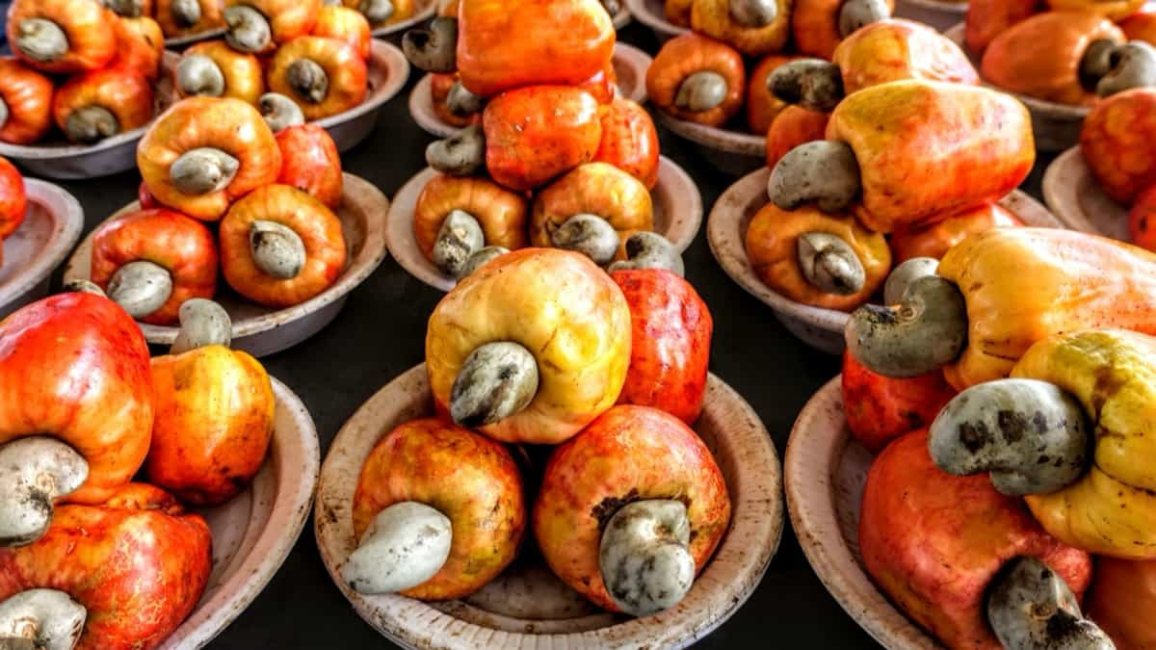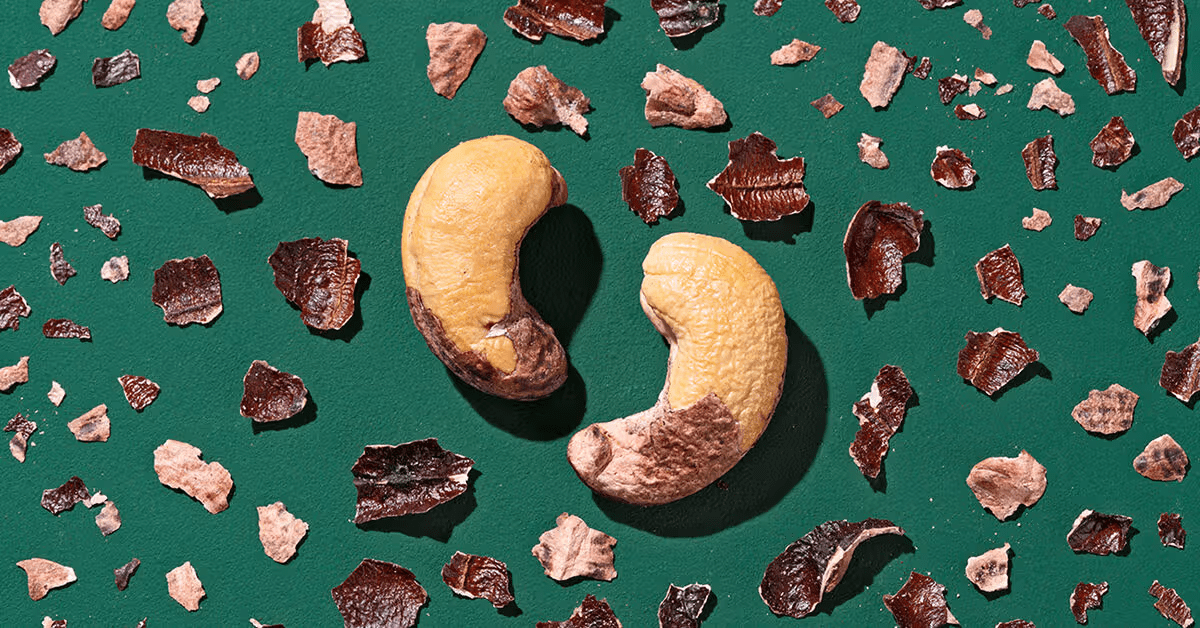Cashews are generally available in prepackaged containers as well as bulk bins. Just as with any other food that you may purchase in the bulk section, make sure that the bins containing the cashews are covered and that the store has a good product turnover so as to ensure its maximal freshness.
Whether purchasing cashews in bulk or in a packaged container, make sure that there is no evidence of moisture or insect damage and that they are not shriveled. If it is possible to smell the cashews, do so in order to ensure that they are not rancid.
Due to their high content of oleic acid, cashews are more stable than most other nuts but should still be stored in a tightly sealed container in the refrigerator, where they will keep for about six months, or in the freezer, where they will keep for about one year. Cashew butter should always be refrigerated once it is opened.
How to Enjoy Cashew
A Few Quick Serving Ideas
- Combining cashews with other nuts and dried fruits makes a healthy snack.
- Right before taking off the heat, add cashews to healthy sautéed vegetables.
Healthy sauté cashews with shrimp, basil and green beans for a delightful Thai inspired dish. Cashews with a little bit of maple syrup make a great topping for hot cereals.
Add cashew butter to breakfast soy or rice milk shakes to up their protein content (a quarter-cup of cashews provides over 5 grams of protein) and give them a creamy nutty taste.
In a saucepan over low-medium heat, mix cashew butter with some soy sauce, cayenne pepper, garlic, ginger and water to make a wonderful sauce for fish, vegetables, tofu or rice.
To roast cashews at home, do so gently in a 160-170°F (about 75°C) oven for 15-20 minutes to preserve the healthy oils. For more on the effect of high heat roasting on nuts.
Read Also: Nutritional Profile and Introduction to Food Rating System Chart of Cashew
What Is a Cashew Nut?
The cashew, known botanically as Anacardium occidentale, is the seed of a tropical evergreen shrub related to mango, pistachio and poison ivy. Commercial growers cultivate cashews in warm, humid climates across the globe; Vietnam, Nigeria, India, Brazil, and Indonesia are among the top producers.
Fast Facts
- Origin: Cashew nuts come from cashew seeds.
- Storage: Airtight container in the freezer
- Shelf life: Frozen, up to one year
What Is a Cashew?
The seeds of most fruits grow within the flesh, but the cashew seed hangs from the bottom of a cashew apple, essentially a swollen stem. A hard shell with two layers encases the kidney-shaped cashew seed, which must be harvested by hand.
Between these two layers lurks the phenolic resin urushiol, which is the same substance that causes the blistering rash seen after contact with poison ivy and poison oak.
The shelling process removes this substance, which is then used in the making of such products as varnish, insecticide, paint, and other industrial products. Because of the potential toxicity, cashews are never sold in the shell.
Fresh cashew apples taste delicious, but only growers and people living near cashew orchards will ever get to enjoy this fruit, as it is highly perishable. Cashew apples begin to ferment immediately after harvesting, and stay fresh no longer than 24 hours.
Highly prized in their growing locale, cashew apples can sometimes be found canned, in jams, or as the base of a liqueur. Commercial producers in Brazil and India package the juice for sale regionally. The cashew tree itself does not go to waste, as the wood is milled into lumber used to build shipping crates and boats.
Cashew Uses

You might see cashews labeled “raw” in the supermarket, but all cashews undergo some heat in the process to remove the shell and caustic substance. Cashews sold as “roasted” have been cooked twice once during the shelling process and then roasted to deepen the color and enhance the flavor, sometimes with salt. You will also find dry-roasted, meaning the nuts were cooked without any added oil.
Because they are high in heart-healthy monounsaturated fatty acids, cashews make some superfoods lists for their concentration of protein, fiber, minerals, and antioxidants. Though technically a seed, the cashew generally gets the culinary treatment of a nut.
You can buy them whole to eat as a snack out of hand or puréed into butter for use as a spread or smoothie ingredient. Owing to their creamy texture when blended, cashews have become a popular ingredient used to make dairy alternatives. This includes cashew milk, nut-based cheese, and nut-based cream sauces and sour cream.
How to Cook With Cashews
Pressed cashews yield a light- to dark-yellow oil better used as a salad dressing ingredient or finishing oil than a cooking oil. It also has cosmetic applications as a skin moisturizer and carrier oil for aromatherapy treatments.
Asian and Indian cuisines frequently include whole or chopped cashews as a stir-fry ingredient and in curries. Vegan cooks turn cashews into animal product-free milk, cream, mayonnaise, butter, and pesto.
What Does It Taste Like?
Cashews have a rich nutty flavor, similar to almonds or peanuts. When pureed, it may be hard to distinguish cashew butter from other nut butter like peanut or almond.
Cashew Substitute
Swapping out cashews depends on how you are using them. If you are using the cashews as nuts in a trail mix or other nut-based recipe, try pine nuts, almonds, walnuts, hazelnuts, or sunflower seeds. If you are swapping the cashews for some other vegan/vegetarian puree, try a combination of zucchini and macadamia nuts or silken tofu.
Cashew Recipes
Try cashews as vegan substitutes or just tasty nuts in these recipes:
- Vegan Cashew Cream
- Buttery Cashew Brittle
- Vegetable Fried Rice With Cashews
Read Also: 11 Recipes That Will Make You Love Broccoli
Storage
Cashews should be kept in an airtight container. They can spoil at room temperature. Refrigerated they can last up to six months and in the freezer, they can last up to one year.
Nutrition and Benefits
A 1-ounce serving of cashews is about 18 whole cashews. This serving size has about 160 calories, 5 grams of protein and 12 grams of fat.1 Cashews contain vitamin C and B and are high in folate. Cashews contain about 13% protein, 71% fat, and 22% carbohydrates.
How to Harvest Cashews Safely

After harvesting cashew nuts, you may want to store them up until you have a decent number, because processing them is a bit of an ordeal. The edible meat of the cashew is surrounded by a shell and a very dangerous, caustic liquid related to poison ivy.
Cashews, Anacardium occidentale are in the same family as poison ivy and poison sumac. Like those plants, the cashew plant contains powerful chemical irritants known as anacardic acids, so handling and eating raw cashews will cause the familiar itchy skin reaction in people sensitive to the chemicals. People who are sensitive to one plant in the family, for example poison ivy, are likely to be sensitive to others.
Why isn’t there a reaction when people eat processed cashew nuts from the grocery store, then? The irritants are found in the shell oil, but not in the nuts themselves. Handling the shell or eating a nut with shell oil on it can cause a reaction.
This is why they’re sold shelled, but why are they roasted? Roasting at high temperature destroys the shell oil, so commercially sold nuts will not trigger a reaction.
Cashew nuts that are still in the shell or that are shelled and roasted at home at lower temperatures may be contaminated with the oil, so, shelling raw cashews is about as much fun as handling poison ivy.
Use Caution when Processing your Cashews
Wear long sleeved clothing, gloves, and goggles to keep the liquid from getting on your skin or in your eyes. Never crack open an unprocessed nut. To process the nuts, roast them outside and never inside, where the fumes can build up and be breathed in. Place the nuts in an old or disposable pan, now your designated cashew pan, as it may never get fully clean of the dangerous cashew oils.
Either cover the pan with a lid or fill the pan with sand until the nuts are covered – the nuts will spit liquid as they heat up, and you want something to catch or absorb it.
Roast the nuts at 350-400 F. (230-260 C.) for 10-20 minutes. After roasting, wash the nuts with soap and water (Wear gloves!) to remove any residual oil. Crack the nut open to reveal the meat inside. Roast the meat in coconut oil for 5 minutes before eating.

